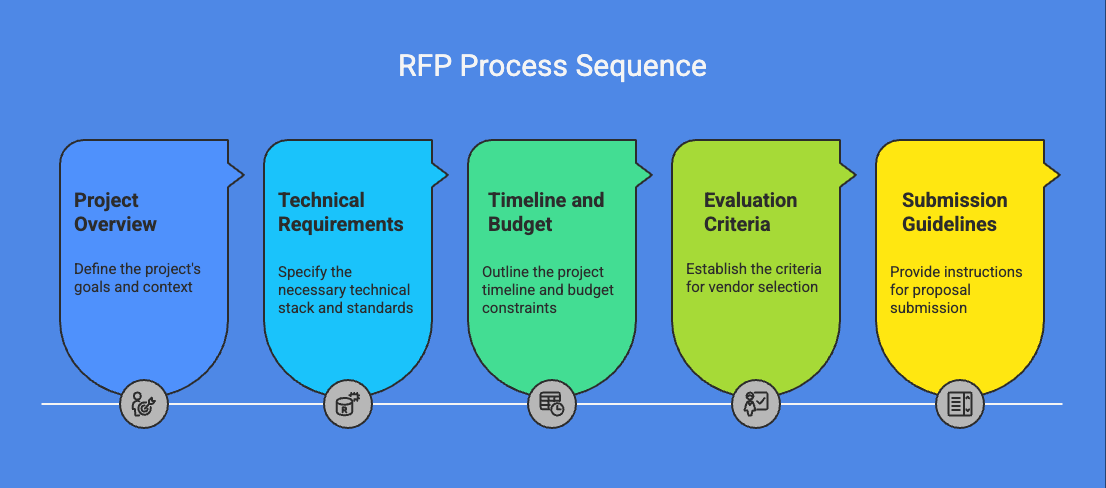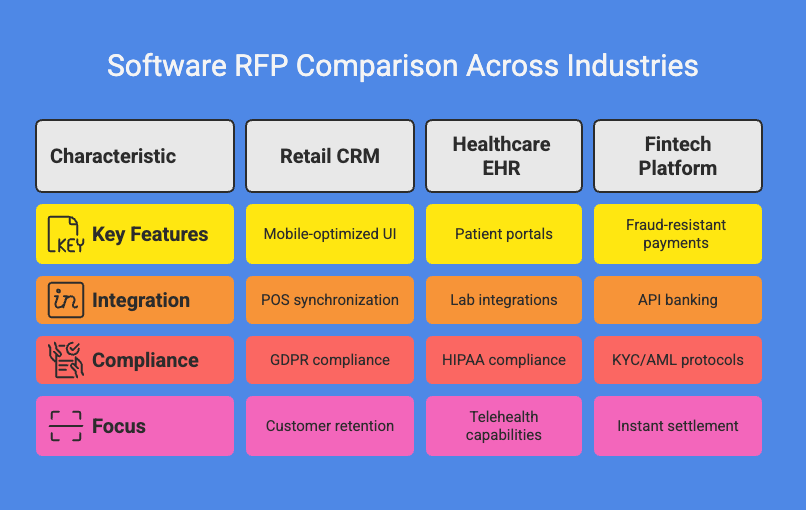You need new software, and a few vendors offer to help. One gives you a price in an email. Another sends over a 50-slide deck. A third shares a detailed plan but misses key goals. Which one do you pick?
That’s the wrong question.
The better question is: Did you give them what they needed to quote the project right?
In 2025, speed matters. So does clarity. Major players like Google and Twilio now use AI to answer RFPs faster, cutting the back-and-forth. Their tools read requests in seconds and draft structured replies. That kind of shift shows how vital the process has become and how much time companies can lose if it isn’t handled right.
Learning how to write a request for proposal for software development is key. An RFP doesn’t just request pricing. It sets the tone, the goals, and the timeline. Get it wrong, and the project slips before it starts.
What is an RFP in Software Development?
What is RFP in software development? At its core, it’s a formal document that outlines your project requirements. It explains what you want to build, what the product should achieve, and how you’ll evaluate the companies that want to work with you.
The purpose is simple: to compare options with facts. Without one, you end up comparing a PowerPoint to a spreadsheet and wondering why nothing lines up.
Procurement teams now spend 60% more time clarifying responses than before. Why? Because projects have more moving parts. AI integrations, cloud dependencies, global teams, it’s no longer enough to say, “We need an app.”
You must explain scope, logic, timelines, constraints, and outcomes. A clear software development request for proposal reduces back-and-forth, fast-tracks planning, and protects your budget from spiraling.
By 2025, most serious development firms will not engage fully without an RFP. It helps you align internal goals and speak the same language as your vendor. It builds trust.
A good software project RFP includes:
- Your goals
- Project background
- Core features
- Tech requirements
- Budget ranges
- Deadlines
- Evaluation process
Why an RFP Matters for Your Software Project
An RFP for software development doesn’t just list what you want. It defines how you get it done. It helps teams stay aligned, vendors stay focused, and projects stay within limits. You avoid chaos later by being structured early.
Here’s why it matters, across functions:
Area of Impact |
How an RFP Helps |
| Strategy | Aligns internal and external teams on purpose and scope |
| Budget | Prevents surprise costs through detailed requirement setting |
| Timeline | Avoids confusion with clear milestones and delivery windows |
| Quality | Sets standards upfront for testing, reviews, and feedback |
| Legal/Compliance | Adds clarity to IP, data rights, and vendor responsibilities |
Improving development outcomes often starts with refining internal processes. Incorporating techniques to improve the software development process can help clarify project needs before finalizing an RFP.
Clarity and Alignment
Miscommunication in tech projects is expensive. One unclear requirement can cost weeks of rework. A missing integration note may break a launch.
But a solid software development request for proposal makes expectations visible to all. Stakeholders, whether from product, tech, or legal, see what the goal is. Vendors know what they’re building. Users get what they asked for.
Without this clarity, people guess. And guessing leads to late nights and missed deadlines.
Vendor Selection
So, how do companies use an RFP when sourcing software?
They use it to compare answers, not just prices. Vendor A may charge less, but Vendor B may have deeper domain expertise. Vendor C might offer better post-launch support. The RFP turns assumptions into metrics. You evaluate proposals based on real alignment, not sales pitch energy.
An RFP lets you check for:
- Relevant experience
- Solution fit
- Timeline match
- Cost realism
- Support quality
Risk Mitigation
Without a plan, scope creep sneaks in. You ask for one thing. Midway, the team adds another. Weeks later, your budget’s gone, and the system isn’t ready.
But a strong software project RFP acts as an anchor. It defines what’s in, what’s out, and what will cost extra. It gives both sides a playbook. If the project veers off course, you refer back.
Well-defined RFPs prevent:
- Feature inflation
- Cost overruns
- Timeline shifts
- Unclear approval
Here are common issues companies face without proper RFPs, and how a good one stops them:
- Missed deadlines → Anchored milestones fix this.
- Budget blowouts → Cost ranges prevent hidden expenses.
- Incompatible builds → Tech stack notes align systems early.
- Vendor mismatch → Evaluation criteria expose weak fits.
Every team working on a digital product, startups, enterprises, NGOs, can avoid weeks of confusion with a clear RFP for software.
A structured RFP doesn’t slow down delivery. It enables it.
One important step in writing a great RFP is deciding whether to build custom software or choose ready-made tools. Comparing custom software and off-the-shelf solutions helps define what’s best for your business case.
Key Components of a Winning Software RFP
Writing an RFP for software development means building a document that works like a blueprint. It guides vendors and internal teams alike. Each part must offer clarity, not clutter. Follow these practical steps to structure yours:

1. Project Overview
Start with a strong summary. This section should describe your organization, the problem you’re solving, and what outcomes you expect. Keep it clear, not fluffy.
Example: “We are a mid-sized retail chain seeking a mobile-first inventory management system. The goal is to track real-time stock across 40 locations and connect with existing POS infrastructure.”
2. Technical Requirements
Your tech stack matters. If you need a platform built in Node.js with PostgreSQL and React, say so. List required APIs, platforms, compliance needs (e.g., HIPAA), hosting preferences, or mobile OS requirements.
Also, note expectations around security, scalability, and uptime.
- Will this system handle 1,000 users or 100,000?
- Does it need to support offline mode?
Make it precise. Otherwise, vendors may under- or over-engineer the solution.
A strong RFP sets the foundation for a successful software project, especially when working with experienced web teams. Many companies begin by exploring web development services that align with their project scope and goals.
3. Timeline and Budget
Vendors need guardrails. If you say “launch in Q4” without details, some may plan for 12 weeks while others plan for 9 months. Instead, break it down:
- RFP issued: March 10
- Vendor selected: April 20
- Kickoff: May 5
- Beta release: August 15
- Final release: September 30
Be honest about budgets. Say you expect a range of $80,000–$110,000. That sets boundaries while allowing for scope flexibility. It also prevents underbidding from unqualified vendors.
4. Evaluation Criteria
Vendors want to know how you’ll choose. Will it be cost-first? Innovation? Past work? Here’s an example scoring table:
| Evaluation Area | Weight (%) |
| Technical Approach | 30% |
| Relevant Experience | 25% |
| Cost Proposal | 20% |
| Timeline Commitment | 15% |
| Innovation Factor | 10% |
This transparency helps serious vendors focus. It filters out those who aren’t a fit and helps teams align on what matters most.
5. Submission Guidelines
Finally, include how to submit, what format you expect (PDF, Slide deck, link to demo), and a deadline. If late proposals won’t be reviewed, say so. Make the process predictable.
For larger or fast-moving projects, extended teams often support in-house staff during development. The role of extended teams in software development is worth considering in your RFP planning.
Examples and Inspiration
OpenAI recently issued RFPs to 16 U.S. states as part of its Stargate program. The project focuses on setting up advanced AI infrastructure. Their documentation requests detail on land acquisition, grid access, and energy sourcing. It’s a great example of how far-reaching a proper RFP can be, even beyond software.
But not every software development request for proposal needs to be massive. Start with a focused approach that matches your use case.

Sample Software RFP Overview
Let’s say you run a mid-size retail chain. You want a CRM system that sales staff can access via tablets in-store and that connects with your eCommerce platform.
Your sample software RFP would include:
- A brief about your current tech setup
- Required features like real-time customer insights, sales dashboards, and automated follow-ups
- Mobile access and performance benchmarks (e.g., load in under 2 seconds on 3G)
- Integration points with your website and inventory system
- Reporting needs
- Regulatory concerns like GDPR compliance
A request for proposal sample for software development in this context may include the following layout:
RFP Summary
CRM system for 50 retail locations with a mobile-first design.
Goals
Boost customer retention and empower in-store associates with real-time sales tools.
Key Features
- Mobile-optimized UI
- Dashboard for store-level analytics
- Customer profile system synced with POS
- Loyalty program integration
Timeline
Kickoff: Q2, Beta: Q3, Launch: Q4
Budget
$90,000–$120,000
Evaluation Criteria
Experience in retail CRM (30%), UX capability (30%), Budget match (20%), Delivery timeline (20%)
Submission Deadline
June 15, 5:00 p.m. EST
Industry-Specific Ideas
Some RFP examples for software are shaped by sector. Consider the following:
- Healthcare: Custom EHR systems with patient portals, appointment scheduling, telehealth, HIPAA compliance, and lab integrations.
- Fintech: Fraud-resistant payment platforms with mobile wallets, instant settlement, API banking, and KYC/AML protocols.
Each one requires a different structure and compliance scope. A fintech RFP might prioritize security architecture, while a healthcare RFP might emphasize usability for non-technical staff and adherence to medical data handling laws.
An effective RFP outlines not just deliverables but also the ideal team composition. Understanding the software development team structure can help you ask for the right skills and roles.
Templates as Starting Points
For most companies, drafting from scratch is overwhelming. A RFP template for software development offers a structured base.
Good templates should include:
- Cover page with submission deadline and contact info
- Section prompts (e.g., “Describe your approach to integration testing”)
- Budget table slots
- Vendor Q&A section
- Milestone chart
Let’s say you’re launching a food delivery startup. You could adapt a template to include a section for real-time GPS tracking, multi-vendor menus, and customer support chat integration.
A software RFP process works best when it is repeatable. Templates give your procurement team that repeatable base. You remove the blank page problem and shorten prep time without losing detail.
Some projects, especially those involving specialized systems, benefit from external partnerships. If your scope includes technical hardware integration, outsourcing embedded software development might be a smart addition to your strategy.
Common Mistakes to Avoid
Even a well-intended RFP for software development can miss the mark if it’s rushed or overloaded. Many teams make preventable mistakes early, then pay for them later during vendor negotiations or project delays. These are some of the most common pitfalls, and how to avoid them:
Mistake |
Problem It Causes |
Better Approach |
| Vague Requirements | Vendors make wrong assumptions, resulting in mismatched proposals | Define outcomes, must-haves, and constraints clearly |
| Overloading Details | Too much information buries key needs and discourages small, capable vendors | Focus on what’s essential to the scope and outcome |
| Ignoring Trends | Missed opportunities for innovation and scalability in the delivered product | Include 2025 standards like AI-readiness and cloud-first logic |
| Skipping Research | Waste time reviewing unqualified proposals | Vet vendor capability before sharing the software project RFP |
If your software development request for proposal isn’t clear or timely, you risk spending weeks explaining what should have been obvious in the document. A good RFP template for software development prevents that and saves internal resources in the long term.
If you’re looking to build the right team after finalizing your RFP, staffing flexibility is key. LITSLINK offers options to hire skilled developers based on your unique project requirements.
The Future of RFPs in Software Development
Looking ahead, the software RFP process is evolving fast. It’s no longer just about documents. It’s becoming smarter, more collaborative, and deeply tied to strategic decision-making.
Digital Tools
In 2025, you can expect to see more AI-powered platforms that assist teams with writing and reviewing RFPs. These tools will suggest phrasing, identify gaps in requirements, and analyze historical outcomes. They’ll reduce writing time while improving accuracy, especially in technical sections.
Collaboration Focus
The days of throwing a static PDF over the wall are fading. The new model prioritizes two-way communication. RFPs will increasingly support agile partnerships where vendors co-create early solutions during discovery sprints.
Sustainability and Ethics
Buyers are asking harder questions. Does your vendor encrypt user data end-to-end? Do they host carbon-neutral infrastructure? Ethics and compliance now influence decisions, especially in global deployments.
Vendors that can answer those questions clearly within the software development request for proposal process will stand out. And companies that prioritize these values inside their RFP in software requests will find stronger alignment from day one.
Conclusion
A well-structured RFP for software development is more than a checklist. It’s a strategy. When built with clarity, research, and relevance to 2025 tech priorities, it creates real alignment between your team and your chosen vendor.
You avoid confusion. You cut delays. You find the right partner faster.
So, whether you’re launching a new fintech platform or rebuilding an internal CRM, now’s the time to start planning your next software project RFP. Use a smart RFP template for software development, understand your scope, and lead with precision.
At LITSLINK, we respond to RFPs with thought, speed, and structure. If you’re preparing your next request for a proposal sample for software development, our team stands ready with industry experience, tailored delivery models, and deep technical expertise.
Better software begins with better planning. Let your RFP lead the way.





